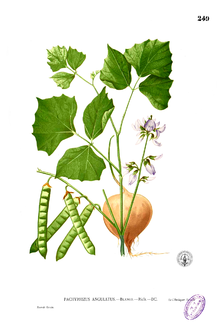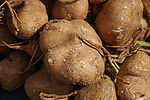- Pachyrhizus erosus
-
Pachyrhizus erosus 
Scientific classification Kingdom: Plantae (unranked): Angiosperms (unranked): Eudicots (unranked): Rosids Order: Fabales Family: Fabaceae Genus: Pachyrhizus Species: P. erosus Binomial name Pachyrhizus erosus
(L.) Urb.Pachyrhizus erosus, commonly known as Jícama (pronounced /ˈhɪkəmə/, Spanish pronunciation: [ˈxikama], from Nahuatl xicamatl, [ʃiˈkamatɬ]), Yam, and Mexican Turnip, is the name of a native Mexican vine, although the name most commonly refers to the plant's edible tuberous root. Jícama is one species in the genus Pachyrhizus. Plants in this genus are commonly referred to as yam bean, although the term "yam bean" can be another name for jícama. The other major species of yam beans are also indigenous within the Americas.
Contents
Botany
The jícama vine can reach a height of 4-5 metres given suitable support. Its root can attain lengths of up to 2 m and weigh up to 20 kilograms. The heaviest jícama root ever recorded is believed to be a specimen found in the Philippines (known as 'Singkamas') in 2010, which weighed about 23 kilograms.[1]
The root's exterior is yellow and papery, while its inside is creamy white with a crisp texture that resembles raw potato or pear. The flavor is sweet and starchy, reminiscent of some apples or raw green beans, and it is usually eaten raw, sometimes with salt, lemon, or lime juice and chili powder. It is also cooked in soups and stir-fried dishes.
In cooking
Jícama is often paired with chili powder, cilantro, ginger, lemon, lime, oranges, red onion, salsa, sesame oil, grilled fish and soy sauce.[2] It can be cut into thin wedges and dipped in salsa. In Mexico, it is popular in salads, fresh fruit combos, fruit bars, soups, and other cooked dishes. In contrast to the root, the remainder of the jícama plant is very poisonous; the seeds contain the toxin rotenone, which is used to poison insects and fish.[3]
Spread to Asia
Spaniards spread cultivation of jícama from Mexico to Philippines, from there it went to Indonesia first and then to China and Southeast Asia, where notable uses of raw jícama include popiah, fresh "lumpia" in the Philippines and salads such as yusheng and rojak.
Jícama has become popular in pie Vietnamese food, where it is called cây củ đậu (in northern Vietnam) or củ sắn or sắn nước (in southern Vietnam). It is known by its Chinese name bang kuan to the ethnic Chinese in Southeast Asia. In Mandarin Chinese, it is known as dòushǔ(豆薯). In the Philippines, jícama is known locally as singkamas and usually eaten with "bagoong" or shrimp paste. The Thai name is มันแกว ("man kaeo"). In Bengali, it is known as Shankhalu. In Hindi it is known as Mishrikand (मिश्रीकंद). In Telugu it is known as 'Kandha'. It is eaten during fast (उपवास) in Bihar (India). In Myanmar it is known as စိမ်းစားဥ. In Malay it is known by the name Ubi Sengkuang.
In Laos, it is called man pao. Here it is a lot smaller and tastes a little sweeter than the Mexican type. It is used as a snack by peeling off the outer layer of the skin, then cutting into bite sizes for eating like eating an apple or a pear.
In Indonesia, Jícama is known as bengkuang. This root crop is only known by people in Sumatra and Java. Mostly they eat it at fresh fruit bars or mix it in the rujak (a kind of spicy fruit salad). Padang city in West Sumatra is called "the city of bengkuang". Local people might have thought that this jícama is the "indigenous crop" of Padang. The crop has been grown everywhere in this city and it has become a part of their culture[citation needed].
Nutrition
Jícama is high in carbohydrates in the form of dietary fiber. It is composed of 86-90% water; it contains only trace amounts of protein and lipids. Its sweet flavor comes from the oligofructose inulin (also called fructo-oligosaccharide) which is a prebiotic. Jicama is high in vitamins C, A and B, along with calcium and phosphorus.
Storage
Jícama should be stored dry, between 12°C and 16°C (53°F and 60°F). Colder temperatures will damage the root; do not refrigerate. A fresh root stored at an appropriate temperature will keep for a month or two.
References
Notes
- ^ 'Heaviest' Singkamas Found in Ilocos
- ^ Green, Aliza (2004). Field Guide to Produce. Quirk Books. p. 194. ISBN 1931686807.
- ^ Duke, James A. (1992). "Handbook of phytochemical constituents of GRAS herbs and other economic plants". Dr. Duke's Phytochemical and Ethnobotanical Databases. CRC Press. http://www.ars-grin.gov/cgi-bin/duke/chemical.pl?ROTENONE. Retrieved 25 June 2010.
External links
Categories:- Crops originating from the Americas
- Faboideae
- Root vegetables
- Tropical agriculture
- Crops originating from Mexico
- Vietnamese ingredients
- Hawaiian cuisine
- Puerto Rican ingredients
Wikimedia Foundation. 2010.



